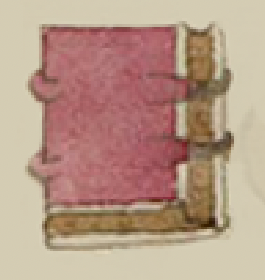breviario (CST18)
This painting of the simplex glyph for the term breviario (breviary, here, a loanword from Spanish that entered Nahuatl), shows a frontal view of a bound book with a red cover (perhaps made of leather?). A small amount of white appears at the outer edges of the red cover. The book has two clasps to keep it closed. The edges of the pages are brown. The companion text notes that this large (huey) book, which cost the town six pesos, was needed at the church.
Stephanie Wood
Most glyphs for the concept of a book show books that are lying open somewhere at about the middle. This one, with its elaborate closing mechanism, stands out as different. For more on the Codex Sierra, see Kevin Terraciano’s study (2021).
Stephanie Wood
ce brevia rio vey
ce breviario huey
Stephanie Wood
1550–1564
Jeff Haskett-Wood
libros, religiosos

breviario, a book containing the service for each day, to be recited by the clergy (a loanword from Spanish that entered Nahuatl), https://nahuatl.wired-humanities.org/content/breviario
breviario
Stephanie Wood
Códice Sierra-Texupan, plate 18, page dated 1558. Origin: Santa Catalina Texupan, Mixteca Alta, State of Oaxaca. Kevin Terraciano has published an outstanding study of this manuscript (Codex Sierra, 2021), and in his book he refers to alphabetic and “pictorial” writing, not hieroglyphic writing. We are still counting some of the imagery from this source as hieroglyphic writing, but we are also including examples of “iconography” where the images verge on European style illustrations or scenes showing activities. We have this iconography category so that such images can be fruitfully compared with hieroglyphs. Hieroglyphic writing was evolving as a result of the influence of European illustrations, and even alphabetic writing impacted it.
https://bidilaf.buap.mx/objeto.xql?id=48281&busqueda=Texupan&action=search
The Biblioteca Digital Lafragua of the Biblioteca Histórica José María Lafragua in Puebla, Mexico, publishes this Códice Sierra-Texupan, 1550–1564 (62pp., 30.7 x 21.8 cm.), referring to it as being in the “Public Domain.” This image is published here under a Creative Commons license, asking that you cite the Biblioteca Digital Lafragua and this Visual Lexicon of Aztec Hieroglyphs.









